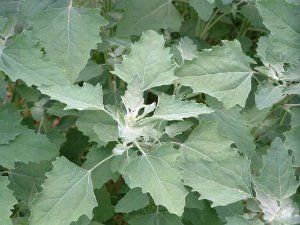Description: Lamb's Quarters, scientifically known as Chenopodium album, is an annual flowering plant belonging to the Amaranthaceae family. Widely distributed across the globe, this plant is often considered a weed but has also been valued for its nutritional content and versatility. It is known for its distinctive, mealy-white coating on the leaves, giving it a frosted appearance.
Habitat and Distribution: Lamb's Quarters is adaptable to a wide range of habitats and is commonly found in disturbed areas, gardens, cultivated fields, and waste places. Native to Eurasia, it has spread to North America and other regions. Its ability to thrive in diverse environments contributes to its widespread distribution.
Physical Features: Leaves: The leaves of Lamb's Quarters are alternate, toothed, and often coated with a white powdery substance, which can be easily rubbed off. The leaves vary in shape, with some being more triangular and others more diamond-shaped.
Flowers: Inconspicuous green flowers are arranged in dense clusters, typically appearing in late spring to summer.
Ecological Significance: Lamb's Quarters plays several ecological roles:
Wildlife Habitat: The plant provides habitat and food for various insects and birds.
Soil Improvement: Lamb's Quarters has taproots that can help break up compacted soil and bring nutrients to the surface.
Cultural Uses:
- Edible: Young leaves of Lamb's Quarters are edible and have been historically consumed as a leafy green vegetable. They are rich in vitamins and minerals and can be used in salads, soups, or cooked dishes.
Control and Management:
- Cultural Practices: Mulching: Applying mulch around desirable plants can help suppress the growth of Lamb's Quarters by blocking sunlight and reducing soil temperature.
- Mechanical Control: Hand Removal: Hand pulling or using garden tools to uproot Lamb's Quarters is effective for small infestations. Be sure to remove the entire plant, including the root system.
- Crop Rotation: Implementing crop rotation practices in agricultural settings can disrupt the lifecycle of Lamb's Quarters and reduce its prevalence.
- Herbicides: Selective herbicides labeled for broadleaf weed control can be used to target Lamb's Quarters. Carefully follow application instructions to avoid harm to desirable plants.
Preventing Spread:
- Early Detection: Regularly inspecting gardens and cultivated areas for signs of Lamb's Quarters is crucial for early detection. Prompt removal or control measures can prevent its spread.
- Limiting Soil Disturbance: Minimizing soil disturbance in areas where Lamb's Quarters is prevalent can help reduce the germination of seeds and the spread of the plant.
- Promoting Desired Vegetation: Encouraging the growth of desired plants in gardens and landscapes can help outcompete Lamb's Quarters and limit its establishment.
In conclusion, while Lamb's Quarters has some nutritional value and ecological benefits, its propensity to spread rapidly and compete with desirable plants makes it a concern in certain settings. Integrated control methods, including cultural practices, mechanical removal, and, if necessary, targeted herbicide application, can help manage Lamb's Quarters and maintain a balanced ecosystem.



